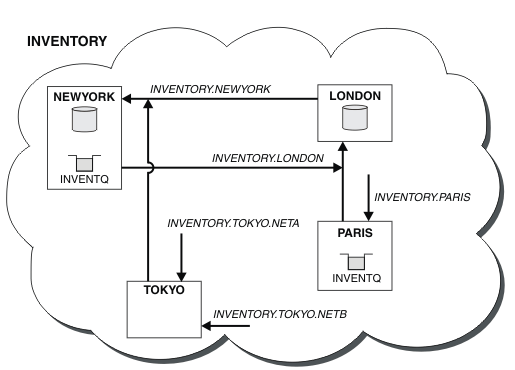Use two networks in a cluster
Follow these instructions to add a new store in TOKYO where there are two different networks. Both need to be available for use to communicate with the queue manager in Tokyo.
Before starting
Note: For changes to a cluster to be propagated throughout the cluster, at least one full repository must always be available. Ensure that your repositories are available before starting this task. Scenario:- The INVENTORY cluster has been set up as described in "Adding a queue manager to a cluster". It contains three queue managers; LONDON and NEWYORK both hold full repositories, PARIS holds a partial repository. The inventory application runs on the system in New York, connected to the NEWYORK queue manager. The application is driven by the arrival of messages on the INVENTQ queue.
- A new store is being added in TOKYO where there are two different networks. Both need to be available for use to communicate with the queue manager in Tokyo.
About this task
Follow these steps to use two networks in a cluster.
Procedure
-
Decide which full repository TOKYO refers to first.
Every queue manager in a cluster must refer to one or other of the full repositories to gather information about the cluster. It builds up its own partial repository. It is of no particular significance which repository you choose. In this example, NEWYORK is chosen. Once the new queue manager has joined the cluster it communicates with both of the repositories.
-
Define the CLUSRCVR channels.
Every queue manager in a cluster needs to define a cluster-receiver on which it can receive messages. This queue manager needs to be able to communicate on each network.
DEFINE CHANNEL(INVENTORY.TOKYO.NETB) CHLTYPE(CLUSRCVR) TRPTYPE(TCP) CONNAME('TOKYO.NETB.CMSTORE.COM') CLUSTER(INVENTORY) DESCR('Cluster-receiver channel using network B for TOKYO')
DEFINE CHANNEL(INVENTORY.TOKYO.NETA) CHLTYPE(CLUSRCVR) TRPTYPE(TCP) CONNAME('TOKYO.NETA.CMSTORE.COM') CLUSTER(INVENTORY) DESCR('Cluster-receiver channel using network A for TOKYO')
-
Define a CLUSSDR channel on queue manager TOKYO.
Every queue manager in a cluster needs to define one cluster-sender channel on which it can send messages to its first full repository. In this case we have chosen NEWYORK, so TOKYO needs the following definition:
DEFINE CHANNEL(INVENTORY.NEWYORK) CHLTYPE(CLUSSDR) TRPTYPE(TCP) CONNAME(NEWYORK.CHSTORE.COM) CLUSTER(INVENTORY) DESCR('Cluster-sender channel from TOKYO to repository at NEWYORK')
Now that we have completed all the definitions, if you have not already done so start the channel initiator on IBM MQ for z/OS . On all platforms, start a listener program on queue manager PARIS. The listener program listens for incoming network requests and starts the cluster-receiver channel when it is needed.
Results
Figure 1 shows the cluster set up by this task.

By making only three definitions, we have added the queue manager TOKYO to the cluster with two different network routes available to it.
Parent topic: Use clusters for workload managementRelated concepts
Related tasks
- Adding a queue manager that hosts a queue locally
- Use a primary and a secondary network in a cluster
- Adding a queue to act as a backup
- Restricting the number of channels used
- Adding a more powerful queue manager that hosts a queue
- Adding a queue manager to a cluster